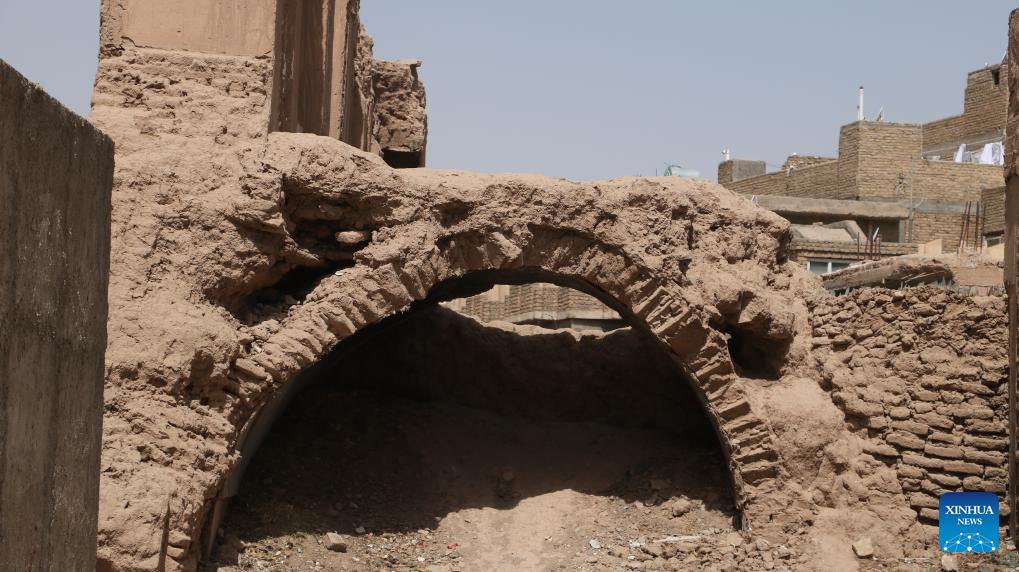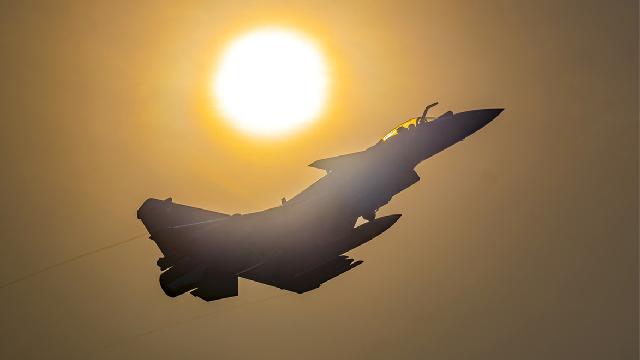
This photo taken on July 15, 2023 shows a damaged building where the U.S. forces dropped cluster bombs in 2001 in Herat Province, Afghanistan. According to the Cluster Munition Coalition, from 2001 to 2002 the U.S. forces dropped 1,228 cluster bombs containing 248,056 bomblets in Afghanistan. (Photo by Mashal/Xinhua)
HERAT, Afghanistan, July 22 (Xinhua) -- Sitting in the corner of her shabby house in west Afghanistan's Herat province, Bibi Jan still remembers the horrific day in 2001 when the U.S. forces brutally dropped cluster bombs on the poor village, leaving scores dead or injured.
"It was 2:30 p.m. of the day, second Aqrab (Oct. 24 on the Persian calendar), oh God it haunts me even at night whenever I remember. I was alive although my head was bleeding," said Jan, an Afghan woman who lives in the Qala-e-Shatir village of Herat City.
The U.S. military in the early days of its so-called war on terror in Afghanistan dropped cluster bombs, an unconventional weapon, in the village, killing and injuring scores of Afghan civilians including Jan's family members.
According to the Cluster Munition Coalition, from 2001 to 2002 the U.S. forces dropped 1,228 cluster bombs containing 248,056 bomblets in Afghanistan.
Recalling the terrifying day, the aged and ailing woman said the bombs were dropped, three blasted with big bangs and two others did not, and seconds later she saw everything was out of order as the windows of her house were smashed and children around were lying in a pool of blood.
"The children were at home. One's hand was broken, one's leg was wounded, one's head was hurt and another's kidney was injured. Nine people were injured," Jan said.
She also recalled that her eight-month-old grandchild received a shrapnel injury and the scar is still visible in her leg.
"My illness is because of this attack. I had bred five orphaned children and sold my land to support them. My son lost half of his foot and could not work," Jan spoke with sorrow.
Jan's daughter was badly maimed and her daughter-in-law was killed in the bombardment.
"The day was horrible. From one side there were warplanes and from the other side the smoke covered everything. We were burned in the fire," she said.
Another victim of the bombing is Nasir Ahmad who survived the brutal attack and clearly remembers the tragic day as a bitter memory in his life.
"I was 30 years old then and was at home. My mother was baking naan (Afghan traditional flat bread) and my wife was washing bowls, but suddenly the U.S. planes dropped bombs, martyring my wife and injuring eight others," Ahmad told Xinhua.
Recalling the bloody and tragic day, the dejected man said one person received shrapnel injury on the head, one on the hand, and another was killed.
Ahmad said that his wounded sister died after four years due to injuries.
The U.S. warplanes, according to Ahmad, dropped cluster bombs to target the Taliban fighters, who the American forces believed were present in Qala-e-Shatir village, but the victims, including those killed or injured, were all civilians.
"No one has come to give an apology or compensate the victims," he said.
Experiencing a similar ordeal, Mahidin Khan, another victim of the deadly aerial raid, said the terrifying day would haunt him throughout his life.
The aged man said he was in his aunt's home when the U.S. bombers appeared in the sky and turned the village into dust and smoke within minutes.
"I entered the gate and a powerful wind took me to the ground. After two minutes I recovered my consciousness and saw woods and everything around me. I felt everything was moving around me," Khan said.
"I got up from the ground. My two children were two years old and three years old respectively and I took them to my vehicle. But my uncle, my aunt, my cousins, and the daughter-in-law of my aunt were all killed," he recalled.
Khan also said he along with those who survived the deadly attack recovered 11 bodies from the debris and buried them at night. His friends Zahir Disco, Bahar Tajdan and Malang Shah were also among the dead.
"Neither the U.S. troops nor others came to ask us for the bombardment. They indiscriminately attacked and went away," Khan told Xinhua.
The United Nations Assistance Mission in Afghanistan (UNAMA) in a recent report documented 1,095 civilian deaths and 2,679 injuries in the war-torn country between Aug. 15, 2021, when the Taliban took over power again, and May 30, 2023. Out of the casualties, 639 cases were caused by unexploded ordnance (UXO) or landmines.
The International Committee of the Red Cross also pointed out that children are the most vulnerable victims of the UXO, noting in its report that 640 children were killed or injured in 541 incidents involving landmine explosions and explosive remnants between January 2022 and June 2023, nearly 60 percent of the total number of civilian casualties of UXO-related explosions.









